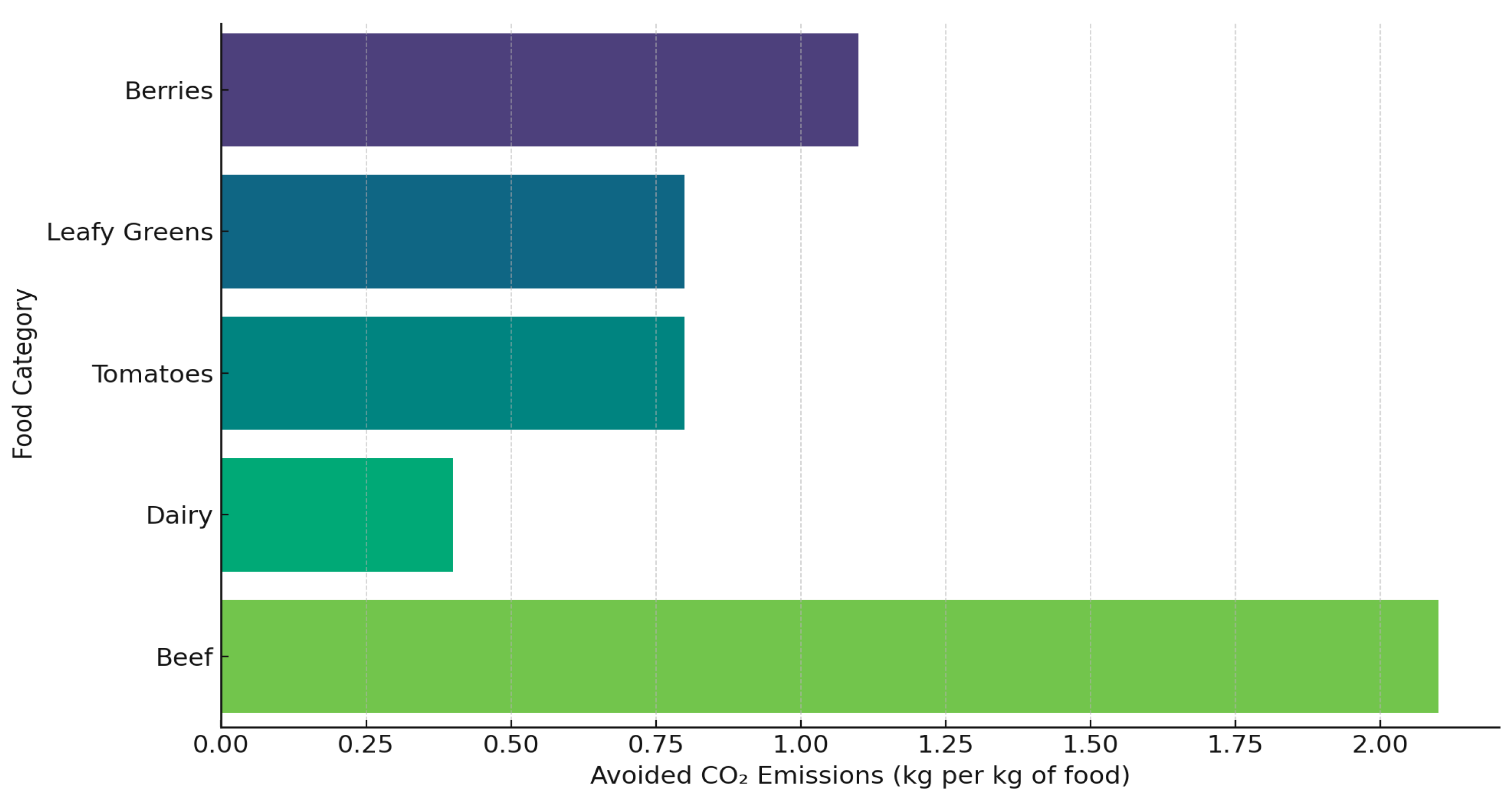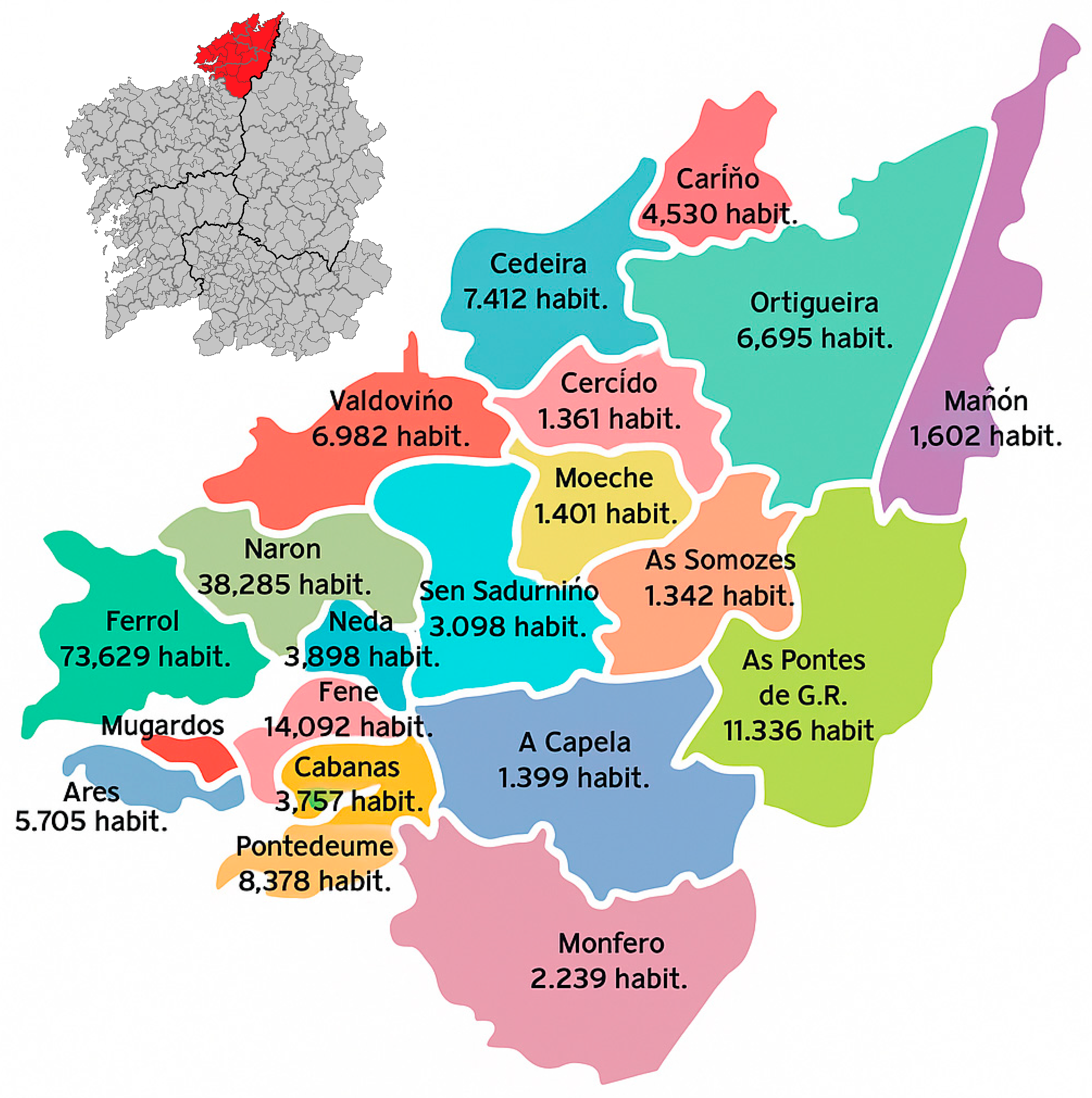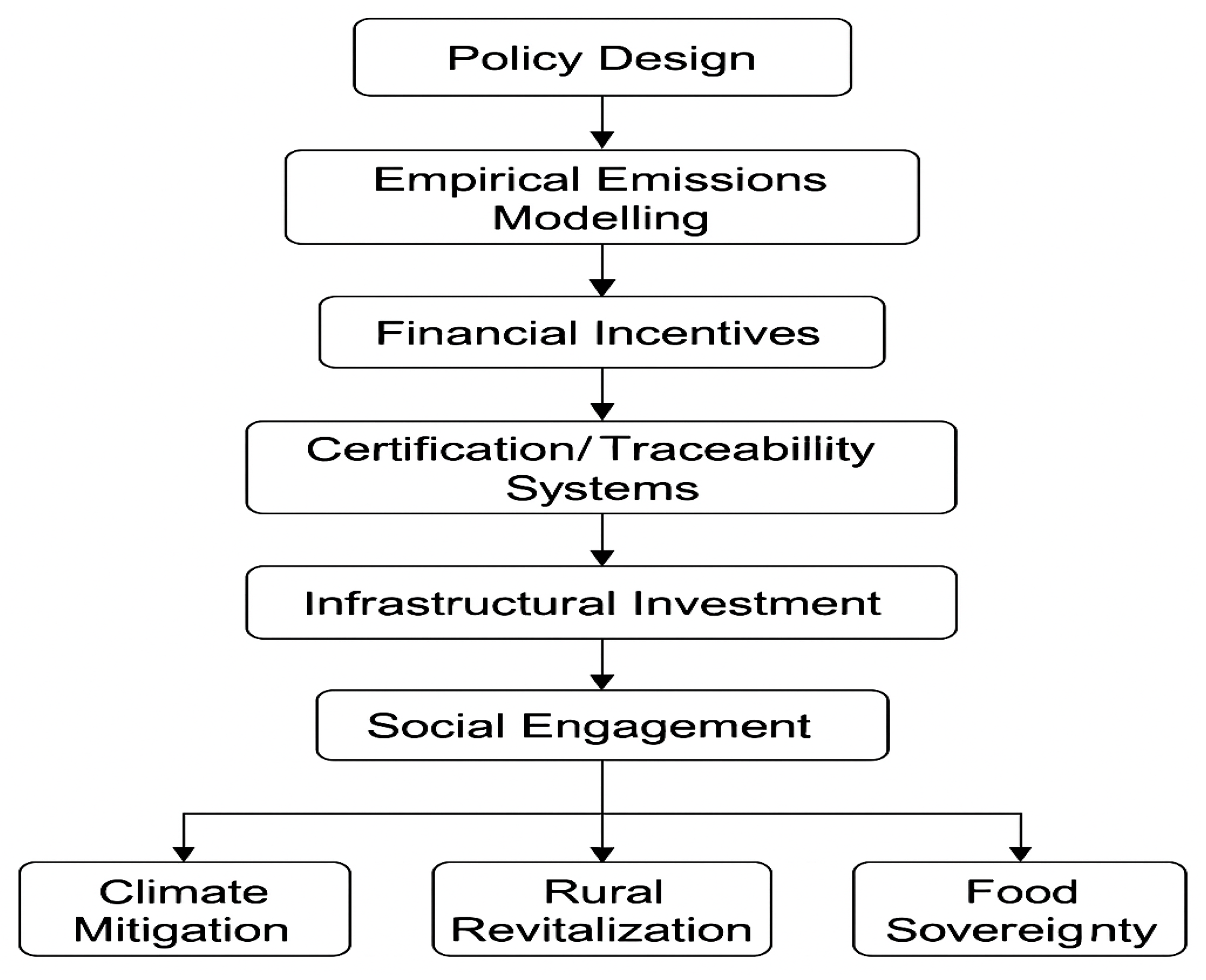4.1. Case Study
Ferrolterra was selected due to its dual characteristics as both a peri-urban and rural area, with a diversified agricultural structure, moderate population density, and logistical underutilization—factors common to many peripheral European regions facing demographic decline. Its agricultural fragmentation, combined with proximity to urban markets, reflects conditions found in parts of Portugal, southern France, and northern Italy. These shared features make it a useful case for assessing the replicability of Km 0 commercialization strategies across the EU.
The region of Ferrolterra, located in the northwest of Spain within the autonomous community of Galicia, was selected as a representative territory to assess the practical applicability of the Km 0 commercialization model. It is characterized by a mix of rural municipalities and small urban centers.
Ferrolterra offers diverse agroclimatic conditions, a significant historical presence of small-scale farming, and untapped potential for localized food systems [
24].
Figure 3 provides a schematic map of the Ferrolterra study area, highlighting the main municipalities involved in the case study and supporting the territorial framing of the analysis.
The panel highlights the comarca’s administrative boundaries, and the mains municipalities included in the analysis, along with population figures. Source: Authors’ elaboration based on Xunta de Galicia cartography and local demographic data (2024).
The study focused on three municipalities within the comarca—Ferrol, Narón, San Sadurniño, and Valdoviño—which together comprise over 120,000 inhabitants and a varied agricultural base including dairy, horticulture, pasture-raised livestock, and small fruit production. The region’s current food supply chain is heavily reliant on centralized logistics, with over 75% of fresh produce sourced from outside the autonomous community [
30,
37]. This dependence results in both economic leakage and increased carbon emissions.
Fieldwork conducted between March and June 2024 included 18 semi-structured interviews with local stakeholders, including farmers, cooperative managers, market organizers, municipal policymakers, and food activists. These conversations revealed a latent but strong interest in reconnecting production with local markets, driven by the decline of traditional farming incomes, rising consumer awareness, and recent EU funding opportunities [
15,
31].
The Ferrolterra comarca covers approximately 500 km2, with around 4200 hectares of utilized agricultural area, according to INE (2022). The region’s agricultural income is primarily derived from dairy production (48%), followed by horticulture (23%), pasture-raised meat (17%), and small fruit farming (9%).
This diversity reflects a multifunctional rural economy with both ecological and economic potential for Km 0 implementation. Farm structures are predominantly small to medium-sized, with an average farm size of 15.6 hectares. The proximity to urban centers (≤25 km) provides logistical advantages for local commercialization.
Table 5 summarizes key agro-socioeconomic indicators for the study area, providing a quantitative profile of its agricultural and logistical characteristics.
This table include agricultural land use, sectoral distribution, and logistical accessibility. This profile supports the selection of Ferrolterra as a representative case for evaluating the Km 0 commercialization model
To assess institutional, logistical, and behavioral aspects of Km 0 commercialization in Ferrolterra, 18 semi-structured interviews were conducted between February and April 2024. The sample included 10 local producers (dairy, horticulture, mixed), 3 cooperative managers, 3 municipal policymakers, and 2 consumer association representatives.
Participants were selected through purposive sampling, targeting actors directly involved in local food systems. Interviews lasted between 45 and 90 min and were conducted in-person or via video call. The interview structure is available as
Supplementary Material S1.
In addition, a consumer survey was carried out in Ferrol during March–April 2024 to understand preferences and price sensitivity regarding Km 0 products. A total of 220 responses were collected through structured questionnaires administered in local markets and online. Respondents were residents of the comarca, aged 18–75, with 54% identifying as regular local food buyers. The main hypothesis was that consumers would be willing to pay more for certified Km 0 products when these were associated with transparent labeling and regional storytelling. Results showed that 68% were willing to pay up to 15% more under such conditions. Key results are summarized in
Table 6, and the full questionnaire is provided as
Supplementary Material S2.
Emissions modeling tailored to Ferrolterra indicated that replacing just 15% of the most commonly imported fruits and vegetables with locally produced alternatives would result in annual CO
2 savings of approximately 140,000 kg [
26,
28]. This calculation assumed an average substitution distance of 600 km, adjusted for regional transport modalities and cold storage requirements. Additional savings are projected through reduced refrigeration and packaging waste, particularly in leafy greens and soft fruits.
From an economic standpoint, the pilot analysis demonstrated a 28% average increase in net revenue for participating farmers engaged in short supply chains and local markets. This figure is consistent with national trends documented by the Spanish Ministry of Agriculture and validated through comparison with similar European case studies [
30,
32].
A consumer survey conducted in Ferrol (
n = 220) revealed that 68% of respondents were willing to pay up to 15% more for certified Km 0 products, especially when accompanied by clear labeling and storytelling emphasizing regional identity and environmental benefits. These findings support the literature emphasizing the embeddedness of local food systems and the role of trust in shaping consumer preferences [
11].
Institutionally, the Ferrolterra Intermunicipal Council has expressed preliminary support for a Km 0 pilot initiative, including potential investment in shared logistics infrastructure and regional branding campaigns.
Key challenges identified include the lack of cold chain facilities at local markets, insufficient digital infrastructure for e-commerce, and the need for legal harmonization in labeling standards. However, as [
38] argue, active logistical engagement by local stakeholders often becomes a crucial driver for alternative and resilient food systems.
Still, the existing network of agricultural cooperatives and civic organizations provides a strong foundation for implementation.
Overall, the Ferrolterra case confirms the technical, economic, and social feasibility of the Km 0 commercialization model in peripheral European regions. It also underscores the importance of targeted public investment and institutional coordination to overcome operational barriers and scale successful practices in line with EU sustainability targets [
18,
20].
While Ferrolterra represents a small to medium-sized application of the Km 0 model, the framework is designed for scalability. Its modular structure—combining emissions modeling, incentive mechanisms, certification systems, and stakeholder engagement—can be adapted to larger territorial contexts within the EU, with appropriate institutional support.
We thank the reviewer for this observation. We have revised the manuscript to clarify how the Ferrolterra case study aligns with the CAP 2023–2027. Specifically, we emphasize the demonstrated reductions in CO2 emissions through local substitution and the development of enabling infrastructure (e.g., distribution hubs, traceability systems, and cooperative platforms). This has been integrated into the final paragraph of the case study section.
4.2. Common Agricultural Policy 2030 Recommendations
The effective institutionalization of Km 0 commercialization within European agri-food systems requires targeted policy interventions, particularly through the Common Agricultural Policy (CAP) 2023–2027.
As the primary regulatory and financial framework for agriculture in the EU, the CAP offers concrete pathways to mainstream Km 0 practices via both Pillar I (direct payments) and Pillar II (rural development) [
18,
19].
A key opportunity lies in the design and implementation of eco-schemes, which Member States can tailor to reward environmentally beneficial practices. Km 0 strategies—such as participation in short supply chains, use of indigenous breeds and varieties, or adoption of low-input production systems—clearly align with the CAP’s eco-scheme objectives.
Member States should therefore explicitly include Km 0 eligibility criteria within their Strategic Plans, ensuring that producers engaged in local commercialization are compensated for their contribution to emissions reduction and rural sustainability [
15].
Moreover, rural development funds under Pillar II can be leveraged to finance essential infrastructure for Km 0 supply chains, including cold storage facilities, small-scale processing units, and digital platforms for logistics and direct sales [
20,
22]. Business model innovation is essential to adapt short supply chains to dynamic market conditions and consumer demands [
39].
These investments are particularly important in peripheral regions like Galicia, where infrastructural gaps currently hinder full participation in localized food economies.
Public procurement policies represent another powerful mechanism. Municipalities and regional governments can use their purchasing power to prioritize Km 0 products in schools, hospitals, and public institutions.
This aligns with CAP objective 9, which promotes the development of vibrant rural areas and encourages the use of public policy tools to support sustainable value chains [
24].
At the regulatory level, the CAP’s cross-cutting objective on knowledge and innovation (AKIS) should be activated to fund extension services, certification systems, and traceability platforms that facilitate market access for Km 0 producers. Member States are encouraged to build partnerships with universities, cooperatives, and NGOs to co-develop these services and disseminate best practices [
25,
32].
Lastly, a dedicated CO2-based incentive mechanism should be piloted within CAP frameworks.
The mechanism would offer per-ton payments for verified emission reductions from local substitution, using EU ETS or national carbon pricing as benchmarks [
21,
26].
Such a scheme would not only reward sustainable practices but also internalize environmental externalities within the food system, thereby enhancing climate accountability at the local scale.
By aligning CAP instruments with the objectives of Km 0 commercialization, the EU and its Member States can create the enabling conditions necessary to scale localized, low-carbon, and resilient food systems. The case of Ferrolterra demonstrates both the feasibility and urgency of such integration.
While Km 0 models offer significant promise, their scalability depends on several enabling conditions. These include investment in cold chain logistics, streamlined administrative procedures for certification, and coordination among small producers.
Furthermore, without long-term commitment from public procurement systems and regional governments, there is a risk that Km 0 markets remain marginal or short-lived. Future initiatives must address these barriers with tailored capacity building and legal frameworks to ensure durability and equity in the benefits.
The implementation of a CO2-based incentive mechanism requires sufficient institutional capacity for monitoring and verification. We acknowledge that such capacities vary across EU Member States. To facilitate adoption, particularly in regions with limited infrastructure, we recommend the use of simplified carbon accounting methodologies and proxy indicators (e.g., average distances avoided, standardized emission factors by product type). These tools would allow for cost-effective integration of the model within CAP Strategic Plans while maintaining transparency and comparability.
For the proposed Km 0 incentive model to be socially inclusive, special attention should be given to small-scale, disadvantaged, or geographically remote producers. These actors often face structural barriers such as limited market access, certification costs, and low economies of scale. Public policy instruments—such as subsidized certification, targeted training, simplified administrative requirements, and technical assistance—can help ensure that these producers are able to participate in and benefit from the carbon-based incentive mechanisms. Their inclusion is essential to achieving both climate and rural development goals.
To ensure institutional coherence, the Km 0 certification and traceability systems proposed in this study can be aligned with the objectives and instruments of the CAP 2023–2027. Specifically, these systems can be integrated into Pillar I eco-schemes that reward environmentally beneficial practices and Pillar II agri-environmental measures that promote local value chains.
Certification protocols based on verifiable origin, low-emission transport, and producer transparency would not only enhance consumer trust but also support the delivery of CAP objectives related to climate action, rural viability, and market resilience.
Before concluding,
Figure 4 illustrates the roadmap proposed for structured integration of Km 0 systems into agricultural policy, based on the empirical findings and Ferrolterra case study. This diagram summarizes the proposed structure combining CAP incentives, emissions modeling, certification, investment, and community engagement as applied in the Ferrolterra case, with potential for replication in other EU regions.
The Km 0 model presented in this study directly supports the principles of the circular economy by shortening supply chains, minimizing packaging waste, and reducing food miles. By prioritizing local inputs and regional consumption, it helps close nutrient loops, strengthens local economies, and decreases the dependence on linear, extractive production systems. Furthermore, integrating Km 0 within territorial food systems fosters the reuse of organic waste (e.g., composting), encourages seasonal consumption, and aligns with EU efforts to decouple resource use from economic growth.










